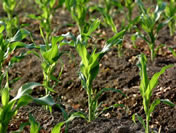|
Let Us Be Prepared Against Instable Cereal Supply!
|
The ending stock of grains at 2005/06 year-end will be much smaller compared to the level of previous year-end, according to "the Global Supply and Demand Forecast for Cereals etc." released by the Ministry of Agriculture, Forestry and Fisheries
(MAFF). In particular, drop in the level of ending stock is big, double digit at 15.5% for corn, whose production shortfall is drastic. We want to remind ourselves of the need to be constantly prepared against unforeseen developments |
 |
as cereal import demand will expand in the future centered around Asia and even as abnormal climate continues world-wide.
The global production of grains in 2005/2006 season is forecast to end up in a decrease of 4.4% compared to the previous season due to droughts in south-western part of Europe and the mid-west of the United States. But the consumption will continue at a high level, thus bringing the year-end stock level below that of the previous year predictably to 351 million tons. We need to be sufficiently watchful of what may happen, depending on cropping situations in the days ahead.
Commodity-wise perspectives reveal that lower harvest is to be worried of corn in the United States, the world largest producer, where drought continued in the main production areas affecting crop growth. On the demand side, feed use is expanding while demand for corn as main ingredient for ethanol production is rapidly expanding in the U.S. In search of cleaner air, ethanol from corn has found expanded use in gasoline production and demand for corn for ethanol production now accounts for 17% of entire demand for corn. A plan puts it that ethanol production should double by 2012 and demand for corn is on a very smooth growth path.
China, while being a net exporter of corn, will export only 3 million tons this year following year-on-year declines in its export volumes, which is a reflection of expanding domestic demand. If the trend continues, it will be a matter of time for China to become a net importer, with possible influence on the end of year stock situation becoming a source of concern.
As for soybeans, while production will decrease in the United States, global production will be slightly up the level of the last year thanks to increased harvests in Brazil and India. Soybean production is changing from the U.S. being a sole center to polarized structure with Brazil and Argentine forming the second pole. Especially, the crop situation in Brazil affects the international price developments. Last year's drought there was serious enough to cause a sharp rise in prices. While this season is predicted to see normal cropping there, there is no room for optimism because the planting has only begun.
China, where soybean consumption is on the rapid rise, predicts import of 27 million tons this year. It is a large importer which takes up 40% of world trade in soybeans. Changing dietary habit there points toward further expanding of import, it is going to be a still more important player in determining demand and supply fluctuations.
Rice is a product whose ending stock is sharply going down. End of the year stock ratio stands lowest in 22 years at 16.1%. That is below the stability level of 17-18% indicated by Food and Agriculture Organization of the United Nations and the world is in a instable situation. In part due to population increase, rice consumption has been on the increasing trend, surpassing growth in production. Under the situation, the international prices have been on the rising trend.
World supply and demand of grains are largely subject to economic development and weather. We should incessantly strive to take measures to enhance self-sufficiency rate of food, in part to prepare against unforeseen developments.
(from an editorial in the September 21, 2005 issue of the Nihon Nogyo Shinbun)
[Top of Page]
|
